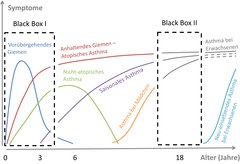2018-09-06
The numerous phenotypes of asthma

Different courses of disease in asthma with 'black boxes' which are in focus of the ALLIANCE research. Click to enlarge (Figure[M]: Fuchs et al., 2018)
DZL clinicians and scientists investigate different courses of asthma from infancy until adulthood in a large longitudinal cohort. They published the study protocol in the recent issue of the journal BMC Pulmonary Medicine.
What constitutes different asthma types? This is one of the questions of the All Age Asthma Cohort (ALLIANCE). Actually, pulmonologists don’t know just one kind of asthma, they know several different ones (see figure and additional news post). One quarter of all children has at least one episode of wheeze during their early childhood. Wheeze is a characteristic sound during exhalation that is caused by constricted airways. Although wheeze might point to a later asthma, only 3-5% of children with wheeze or other early symptoms suffer from a persistent asthma until adulthood. In another subgroup of patients, asthma starts only in adulthood. They often suffer from severe symptoms.
For prediction and treatment of asthma, DZL started the ALLIANCE Cohort already in the first funding period. More than 600 patients (between six months and 75 years) and almost 200 healthy persons have been included until now. They come for follow-up visits every year. The ALLIANCE study team determines parameters of patient’s lung function and airway inflammation and checks skin sensitization to specific antigens. Biomaterials as blood, nasal brushes, sputum and exhaled air are collected and analyzed. Questionnaires and data from patient’s health records document symptoms, course of the disease, life style and environmental factors. In order to ensure comparability, the spectrum of examinations of children and adults is kept similar. Nevertheless, not all tests can be performed in the same way and extent with children.
The molecular mechanisms of different courses are investigated by ‘deep phenotyping’. Data and biobanks of the ALLIANCE Cohort comprise hundreds of thousands of data points and biomaterial samples. First analyses started recently. „At present, we can only trace pathological changes of the airways late or too late”, says Dr. Thomas Bahmer from LungenClinic Grosshansdorf (DZL site ARCN). „Therefore we try to find substances in blood or exhaled air which tell us early that there is a possible risk or a certain course of the disease.” Moreover, scientists developed a new technique for measuring inflammation markers in nasal secretions. „If the nasal mucosa – as part of the upper airways – can provide information on the lower airways – which are difficult to reach by diagnostic methods – we had a better and simpler method in hands”, says Dr. Oliver Fuchs, pediatric allergologist from Inselspital Bern and Children’s Clinic of University Medical Center Schleswig-Holstein at Lübeck. „Especially in little children, this low-risk technique might play an important role in future.“
ALLIANCE is one of the large clinical flagship projects of DZL. The DZL sites ARCN, BREATH, UGMLC and CPC-M are participating as well as the DZL-external partner University Medical Center Cologne. University Medical Center Schleswig-Holstein (Campus Lübeck), Medical School Hannover, University Hospital of Gießen and Marburg, Hospital of the University Munich and University Medical Center Cologne are collaborating in the pediatric arm. Adult patients are recruited at LungenClinic Grosshansdorf and at Research Center Borstel.
Further Information:
Fuchs O*, Bahmer T*, Weckmann M, Dittrich AM, Schaub B, Rösler B, Happle C, Brinkmann F, Ricklefs I, König IR, Watz H, Rabe KF**, Kopp MV**, Hansen G**, von Mutius E** (2018) The all age asthma cohort (ALLIANCE) – from early beginnings to chronic disease: a longitudinal cohort study. BMC Pulm Med 18: 140 (ARCN, BREATH, CPC-M) (*shared first authorship, **shared senior authorship)
External link to the journal paper
/jbul
Calendar
Upcoming events
2024-04-30
Virtual DZL AID Kick-off Seminar
2024-05-29
74th Meeting of ARCN
2024-06-05
